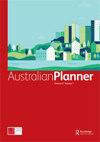Tiny houses desirable or disruptive?
IF 1.2
Q2 Social Sciences
引用次数: 2
Abstract
ABSTRACT What happens when tiny houses on wheels [THOW] disrupt the foundations on which we have built our planning and building industry? The very concept of a house being a transportable product seems to defy the planning and building framework we have constructed around our housing industry for decades. But rather than seeing them as disruptive and challenging, THOW could be a solution we’ve all been searching for to the wicked problem of affordable housing. In recent decades, the tiny house movement has flourished in Europe and America, with an industry of builders, designers, real estate agents and property owners tapping into the tiny economy. The establishment of Australian companies specialising in THOW shows there is a need for planning to catch up with market demand as houses are being constructed, yet certainty of obtaining approval varies considerably between local governments. A combination of planning, building and transport regulations are the largest barriers restricting the growth of THOW as an acceptable housing form in Australia. If tenancy of THOW can be legitimised through planning or building approvals, then regulatory red tape and various economic barriers such as the ability to obtain financing and insurance for THOW may be ameliorated.小房子是理想的还是破坏性的?
摘要:当车轮上的小房子破坏了我们规划和建筑行业的基础时,会发生什么?房子是一种可运输产品的概念似乎违背了我们几十年来围绕住房行业构建的规划和建筑框架。但是,THOW可能是我们一直在寻找的解决经济适用房这一邪恶问题的方案,而不是将其视为具有破坏性和挑战性的方案。近几十年来,小房子运动在欧洲和美国蓬勃发展,建筑商、设计师、房地产经纪人和业主组成的行业正在利用这个小经济。澳大利亚专门从事THOW的公司的成立表明,随着房屋的建设,有必要制定计划来满足市场需求,但获得批准的确定性在地方政府之间存在很大差异。规划、建筑和交通法规的结合是限制THOW作为澳大利亚可接受的住房形式发展的最大障碍。如果THOW的租赁可以通过规划或建筑批准合法化,那么监管的繁文缛节和各种经济障碍,如THOW获得融资和保险的能力,可能会得到改善。
本文章由计算机程序翻译,如有差异,请以英文原文为准。
求助全文
约1分钟内获得全文
求助全文

 求助内容:
求助内容: 应助结果提醒方式:
应助结果提醒方式:


